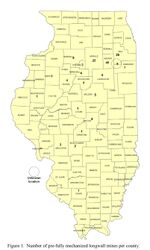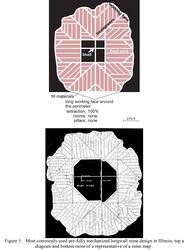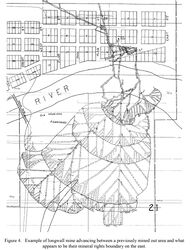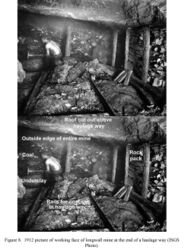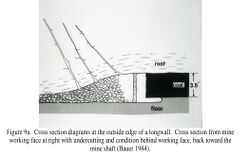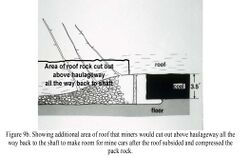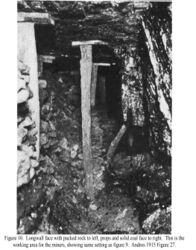History of Longwall Coal Mining In Illinois
By Robert A. Bauer, Illinois State Geological Survey (7-2015)
Citation: Bauer, Robert A., 2015 (version), History of Longwall Coal Mining in Illinois, Illinois State Geological Survey, Unpublished Manuscript Files, pp. 15.
Download
Introduction
The first longwall coal mining started in the late 1600s in Great Britain and was first used in Illinois in 1856. The earliest longwall mining had all parts of the operation performed by hand and utilized many different extraction designs. Over time, various parts of the longwall mine operation were mechanized culminating in the 1950s and 1960s when it became fully-mechanized with specifically designed equipment for the operation.
Pre-Fully Mechanized Longwalls
Longwall Coal Mining Started in Great Britain
The longwall coal mining method started about 175 years before appearing in Illinois. Mining historians find that the longwall method started in Great Britain in the late 1600s in Shropshire County (Galloway 1882, Hatcher 1993). Flinn (1984) notes that from 1700 on, in Great Britain, there was a national trend away from room-and-pillar mining toward the longwall method to a point that by 1900, seventy-five percent of the coal produced was by the longwall method (Church 1986).
Illinois Longwall Mining
According to available records, longwall mining started in Illinois shortly after 1856 in LaSalle County at the LaSalle Mine of the LaSalle County Carbon Coal Company (Harris 1918). This mining method was used in over 161 mines in 19 counties (figure 1). These pre-fully mechanized longwall mines operated from about 1856 through 1954 (figure 2)with most of them starting this practice in the 1870s & 1880s. Records and maps show that over 161 mines used this method in Bureau, Christian, Grundy, Kankakee, Knox, LaSalle, Livingston, Logan, McDonough, McLean, Macon, Macoupin, Marshall, Montgomery, Peoria, Putnam, Will and Woodford Counties and one experimental panel in Perry County. There are most likely other mines and counties where such mining took place as indicated by Young’s (1917) example of an experimental panel longwall in a mining district that contains Franklin, Jackson, Perry and Williamson Counties and that “several plans are now being tried or considered for the more nearly complete extraction of the coal in this district.” These longwall mines in Illinois, most often operated in the Colchester No. 2 Coal seam, but also operated in other coal seams; Assumption, Rock Island No. 1, Lowell, Cardiff, Springfield No. 5, Herrin No. 6 and Danville No. 7.
The use of the term longwall, long-wall or long wall in Illinois was used by the earliest mine inspectors in their reports to the Governor. The First Biennial Report of the Bureau of Labor Statistics of Illinois (1881) contains “Coal Mine Inspectors’ Returns” to the Governor of Illinois for the years 1879 and 1880. The 1879 report remarks about the characteristics of several mines in LaSalle County that are using the “long wall plan”.
Longwall Mining Method in Illinois
As was the case in Great Britain, longwall mining in Illinois used many different overall designs, but shared similar elements of removing all coal along a continuous face, placing or packing rock into the area where coal was removed, downward movement of the roof and overburden where the coal was removed and lowering of the ground surface. From available mine maps in Illinois, it appears that the most common longwall design removed all the coal starting near the shafts (vertical entrance) to the coal seam/mine and moved outward away from the shafts (figure 3). This is generically called an advancing longwall since the operation is moving away from the entrance. Not all mining was concentric, moving away from the shaft in all directions. Some mining operations advanced faces in one direction between adjacent mined out areas or to accommodate mineral rights boundaries (figure 4) and others used large advancing longwall panels (figure 5). Another longwall operation used the retreating method of first outlining a panel with entryways and removing the coal as the longwall face retreated toward the entrance of the panel (figures 6 & 7).
No matter what type of longwall extraction design used, the mining operation at the face was similar. At the working face (figure 8), the miners first removed part of the underclay, layer from below the coal seam (i.e. undercut the seam) or under certain geologic settings, the cut was made in the lower part of the coal seam. In early mining, this task was done by hand and later by undercutting machines. The coal was then pried down or allowed to fall from the roof rock, and then carried to coal cars in the roadways or loaded onto chutes or metal conveyors along the working face. Waste materials of underclay from undercutting the coal, roof rock that came down with the coal or unwanted impurities in the coal were placed opposite the working face between the pack walls of rock that were built on either side of the roadways/haulageways.
The pack walls and stowed waste materials made a yielding support, which prevented a sudden break in the roof at the face and allowed a gradual lowering of the mine roof and overburden. The weight of the overburden greatly compressed the fill about 200 to 300 feet behind the working face (Herbert and Rutledge 1925) (figures 9a & 9B). When this occurred, subsidence resulted at the ground surface over the entire mined area. This is noted in the 1883 Statistics of Coal Production in Illinois in reference to mining in the Braidwood, Illinois area: …”all coal in this field is worked on the long-wall system, and as fast as the mineral is removed the surface comes down with the roof..”.
Young (1916) contrasted the effects of subsidence from longwall mining and room-and-pillar mining: “It may be said that in general the surface effects of longwall mining are more uniform than those resulting from room-and-pillar and panel workings. This is due principally to the gradual sinking of the roof in longwall mining where the same gradual movement generally extends through the overlying rocks toward the surface. Upon the surface the evidences of subsidence will be a gentle sag, and where the longwall face is stopped there may be a more or less well-defined terrace outlining in a general way the area that has been undermined”. The publication describes the impacts on agricultural land and remedies, how structures behave as undermined and towns that attributed trouble with their water and gas mains to longwall subsidence.
Fully Mechanized Longwalls in Illinois
Starting in 1962, fully-mechanized longwall operations were tried in Illinois. From 1962 through about 1973, ten longwall faces in Illinois that were of limited economic success were tried. These attempts by Old Ben Coal and Freeman Coal Mining Companies are presented in two papers found in the Illinois Mining Institute, volume 81, pages 24-38 (1973). The number of “faces” is not the same as panels. In some panels, face widths were reduced in an attempt to improve conditions at the working face.
Old Ben Coal Mining Company started with a mechanized longwall face in 1962 in Mine No. 21. All 6 of their faces were in Mine No. 21. Freeman Coal Mining Company started a mechanized face in 1965 in their Orient No. 5 Mine. In 1971, a mechanized longwall face was employed in Orient No. 6, where a total of 3 different faces were tried. The first longwalls that were considered successful for production purposes were installed in Old Ben No. 24 in 1976 as a longwall demonstration project which better matched equipment to the geologic conditions.
Since these early longwall panels, over 240 fully-mechanized longwall panels have operated in 6 Illinois counties (D. Barkley, Personal communications 2007). Longwall panels today in Illinois range from 900 to 1,250 feet wide, up to 2.6 miles long (Fiscor 2007), and 330 to 970 feet below the ground surface. In 2005, 53% of the coal produced in Illinois was mined using the longwall method (Illinois Office of Mines and Minerals, 2005 Annual Statistical Report), which is similar to the percentage mined in the nation by longwalls (Weisdack and Kvitkovich, 2005).
References
Andros, S.O., 1915, Coal Mining In Illinois. Illinois Coal Mining Investigation Co-Operative Agreement, Bulletin 13, 250 p.
Bauer, R.A. 1984. Subsidence of bedrock above abandoned coal mines in Illinois produces few fractures. SME-AIME Fall meeting, Denver, Colorado. Preprint No. 84-400, 8 p.
Church, R., 1986. The History of the British Coal Industry; Volume 3, 1830-1913: Victorian Pre-eminence, 813 p.
Fiscor, Steve, 2007, U.S. Longwall Census, Coal Age, Vol. 112, No. 2, pp. 30-38.
Flinn, M.W., 1984. The History of the British Coal Industry, Volume 2, 1700-1830: The Industrial Revolution, 492 p.
Galloway, R.L., 1882. A History of Coal Mining in Great Britain, 273 p.
Harris, G.W., 1918. Longwall Mining at LaSalle, Illinois. Coal Age, vol. 14, no. 9, pp. 388-392.
Hatcher, J., 1993. The History of the British Coal Industry, Volume 1, Before 1700: Towards the Age of Coal, 656 p.
Herbert, C.A., and J.J. Rutledge, 1927. Subsidence Due to Coal Mining in Illinois. U.S. Department of Commerce, Bureau of Mines, Bulletin 238, 59 p.
Illinois Office of Mines and Minerals, 2005. Annual Statistical Report at: [1]
Toenges, A.L., 1936. Longwall Mining Methods in Some Mines of the Middle Western States, U.S. Bureau of Mines, Information Circular 6893, 61 p.
Weisdack, George. V. and James F. Kvitkovich, 2005. Importance of longwall mining to the coal industry: Mining Engineering, Vol. 57, No. 12, pp. 21-26.
Young, C.M., 1917. Percentage of Extraction of Bituminous Coal with Special Reference to Illinois Conditions. University of Illinois Eng. Experimental Station Bull. 100, v. XIV, No. 42, June 1917, 175 pp.
Young, L.E., 1916. Surface Subsidence in Illinois Resulting from Coal Mining. Illinois State Geological Survey, Mining Investigation Bulletin 17, 113 p.

